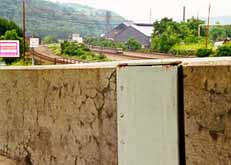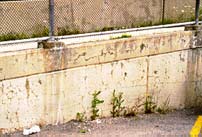U.S. Department of Transportation
Federal Highway Administration
1200 New Jersey Avenue, SE
Washington, DC 20590
202-366-4000
Focus
| Accelerating Infrastructure Innovations |
Publication Number: FHWA-RD-99-108
Date: October 1999
Alkali-silica reactivity (ASR) is a pervasive problem in almost all States, occurring beneath the surface of portland cement concrete (PCC) and causing cracks, spalling, and other damage in pavements and structures. To help highway agencies and others learn how to protect new PCC roads and bridges from ASR, the ASR Lead States team has prepared a draft guide specification. The specification, titled "Portland Cement Concrete Resistant to Excessive Expansion Caused by Alkali-Silica," is currently undergoing review by the American Association of State Highway and Transportation Officials (AASHTO) Subcommittees on Construction and Materials.
ASR occurs when silica in some aggregates and alkalis in cement combine with water to form a gel-like substance on the aggregate surface. As the gel expands, it causes the concrete to crack. Over time, the cracks can cause permanent damage and even structural failure.
The composition of the aggregate is a key indicator of susceptibility to ASR. "The problem has nothing to do with the quality of the aggregates," states Margo Thomson of the Pennsylvania Department of Transportation (DOT) and leader of the ASR Lead States team. "It has to do with the geology of the aggregate deposits. Some States do not have widely available nonreactive aggregate deposits; other States' deposits contain significant amounts of chert, flint, or other siliceous matter. Moreover, there can be a great deal of variance in aggregate composition within one aggregate source. More and more States have taken to shipping in their aggregate supplies from out-of-State or even foreign sources, so finding a reliable nonreactive aggregate source is at best unpredictable.
 |
 |
| Exhibiting cracking from mild ASR, this Johnstown, PA, bridge is being considered as a field test site for a lithium-based remediation treatment. | |
"There is a need for States to develop a more global view of the problem," says Thomson. "And no State is in a position to accept aggregate for use without evaluating it first for ASR potential. The specifications the ASR Lead States team has developed outline a number of steps for addressing these issues. If we have to use aggregate with ASR potential, then we should have a reliable guide specification to provide those steps. This is what the team meant to achieve."
In addition to providing steps to deal with aggregate-related problems, the guide specification offers some cement-related strategies for combating ASR. These include the use of low-alkali cement, as well as incorporating fly ash or lithium in the mix.
The ASR Lead States team is composed of several States (New Mexico, North Carolina, Pennsylvania, South Dakota, and Virginia) with extensive experience in tackling ASR. The team also includes representatives from industry and the Federal Highway Administration (FHWA).
To determine whether the guide specification would be published by AASHTO, the AASHTO Highway Subcommittee on Construction distributed ballots to all State highway agencies. Most of the ballots have been returned, and the response to date has been almost universally favorable, according to Frank Gee of the Virginia DOT and vice chair of the Subcommittee on Construction. "Following a final review for publication, 'Portland Cement Concrete Resistant to Excessive Expansion Caused by Alkali-Silica' will be published in standalone form by the AASHTO subcommittees. The States will be free to refine it as they see fit," notes Gee. "It is also likely to be incorporated into the next edition of the AASHTO Guide Specifications for Highway Construction, scheduled to be published sometime in the next several years."
| Although the existence of ASR has been known for many years, it remained a largely invisible problem for much of that time. To provide practitioners with visual aids in identifying ASR, the Handbook for the Identification Of Alkali-Silica Reactivity In Highway Structures was published in 1991 under the Strategic Highway Research Program (SHRP). It can be obtained by contacting the Transportation Research Board Business Office at 202-334-3213 (fax: 202-334-2519; Web: www2.nas.edu/trbbooks). The book number is PC 315, and the price is $10.00. |
As Thomson says, "A lot of work has gone into writing the guide specification. Our hope in its adoption is to provide States the help they need with their aggregates." A copy of the draft guide specification, as well as a bibliography of literature on ASR and a list of resources, are currently available on the Lead States Web site (leadstates.tamu.edu/ASR/library/gspec.stm).
For more information, contact Margo Thomson of the Pennsylvania DOT at 717-787-1931 (fax: 717-783-5955; email: mct@ezonline.com) or Frank Gee of the Virginia DOT at 804-786-2783 (fax: 804-786-7778; email: gee_cf@vdot.state.va.us).
